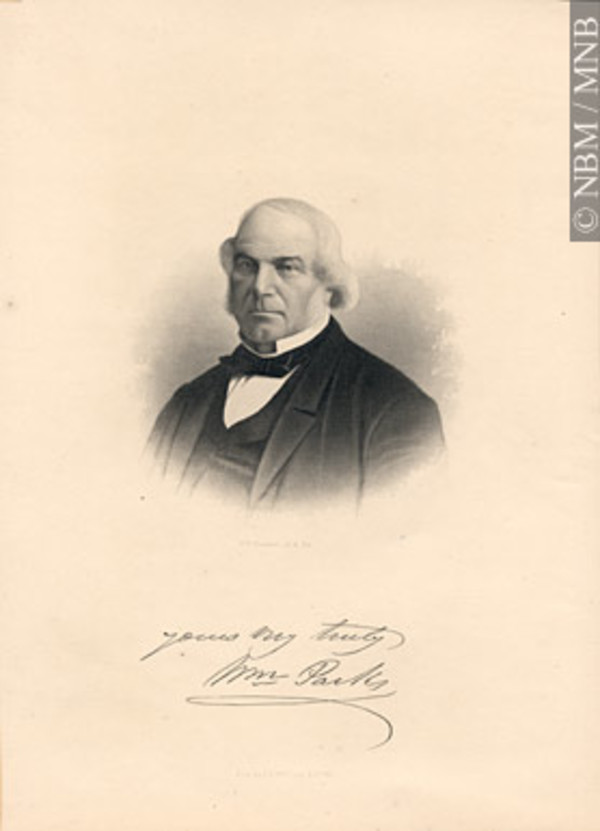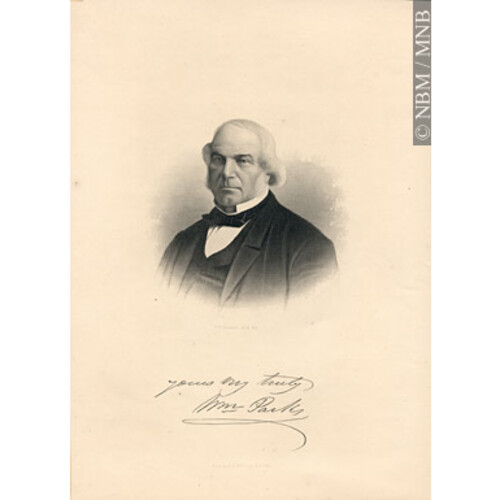
Source: Link
PARKS, WILLIAM, merchant; b. 11 Feb. 1800 at Buckley, County Monaghan (Republic of Ireland); m. Ann Hegan in Ireland, and they had five sons and two daughters; sailed late in 1870 from Halifax for Liverpool aboard the ss City of Boston, which disappeared.
Although the surviving record does not admit of a personal portrait of William Parks, it is sufficient to indicate that during the middle decades of the 19th century he was a leader in the commercial and religious affairs of Saint John, N.B., when that port was a centre of commerce in British North America. Parks, somewhat typically for a prominent merchant of his day, had wide business interests. They extended from the operation of an import and retail establishment through shipowning and banking to the manufacturing of cotton.
William Parks had immigrated to New Brunswick in 1822 and settled in Saint John. He apparently began in the grocery and dry goods business. In the early 1840s he went into shipowning. The 737-ton Lady Sale, built by Francis and Joseph Ruddock, was the first of nine vessels owned by Parks in the years 1843 to 1867, five of which were retained for long periods. Until 1846 he usually owned his vessels with John Hegan, with whom he may have been in general partnership and to whom he was probably related by marriage. In 1847 Parks went into partnership with his eldest son, Samuel. In the firm, styled as William Parks and Son, the father was the dominant partner at least until 1860. Samuel died in 1863 and another son, John Hegan Parks, a civil engineer, apparently took his place.
Shipowning was probably only of secondary interest to William Parks, who took a more or less important role in many of the commercial institutions of Saint John. He was an active member of the city’s board of trade. By 1849 he was a director of the Commercial Bank of New Brunswick, which was long Saint John’s largest bank, and he was president for the last seven years of his life. Parks was a substantial investor in the Saint John Gas Light Company, the Saint John Water Company, and, it would appear, the New Brunswick Marine Insurance Company. Moreover, he was a prime mover, and the president from 1865, of the locally much championed Western Extension Railway. This enterprise, which envisaged the western extension of the European and North American Railway from Saint John to the New England states, was seen by the anti-confederate forces in New Brunswick as the economic basis for an alternative to confederation with Canada, and as such drew heavy fire from those favouring confederation. The Halifax Citizen stated that “The New Brunswickers in laying down the rails to the boundaries, would be forging link after link of a chain which would inevitably bind them to the chariot wheels of the North” of the United States. Perhaps Parks’ most commercially conspicuous venture was his founding in 1861 on Courtenay Bay of the New Brunswick Cotton Mill. His son John was also active in founding and running the mill and in due course inherited it. It is a tribute to William Parks’ commercial acumen that the setting up of the cotton mill was well timed to take advantage of the general disruption in cotton manufacturing caused by the American Civil War.
Parks was prominent in the religious life of Saint John in the mid 1840s. In 1843–44 he led the Irish members out of the Scots-dominated St Andrew’s Church to form Saint John Presbyterian, and he played the main part in obtaining Irish clergymen for the new congregation – Robert Irvine in 1844 and, after his resignation in 1852, William Elder. Parks was an evangelical of note, and served on the executives of the Bible Society and the Evangelical Union, an interdenominational organization of evangelical Christians founded in 1846 “to secure perfect equality in civil privileges among all denominations. . . .” He was drawn into the latter’s political wing, the Election Society, which opposed the privileged position of the Church of England in New Brunswick. Parks stood for a time as a candidate for the society in the provincial election of 1846, but withdrew before the polling.
William Parks emerges as an energetic, respectable, and prominent entrepreneur of his time. Equally he appears as a man of his place, of Saint John. His business interests bore a peculiarly Saint John stamp; indeed his railway enterprise epitomized the strong current of anticonfederate opinion which was then running through the mercantile class of the port.
N.B. Museum, Parks family papers. PAC, MG 9, A10, 5, p.7 (mfm. at N.B. Museum). PRO, BT 107–8. Loyalist (Fredericton), 22 Sept. 1846. New Brunswick Courier, 28 March 1846. Canadian biographical dictionary, II, 634–35. The merchants’ and farmers’ almanack . . . (Saint John, N.B.), 1849. Davin, Irishman in Can. MacNutt, New Brunswick.
Cite This Article
Richard Rice and T. W. Acheson, “PARKS, WILLIAM,” in Dictionary of Canadian Biography, vol. 9, University of Toronto/Université Laval, 2003–, accessed December 30, 2025, https://www.biographi.ca/en/bio/parks_william_9E.html.
The citation above shows the format for footnotes and endnotes according to the Chicago manual of style (16th edition). Information to be used in other citation formats:
| Permalink: | https://www.biographi.ca/en/bio/parks_william_9E.html |
| Author of Article: | Richard Rice and T. W. Acheson |
| Title of Article: | PARKS, WILLIAM |
| Publication Name: | Dictionary of Canadian Biography, vol. 9 |
| Publisher: | University of Toronto/Université Laval |
| Year of publication: | 1976 |
| Year of revision: | 1976 |
| Access Date: | December 30, 2025 |



